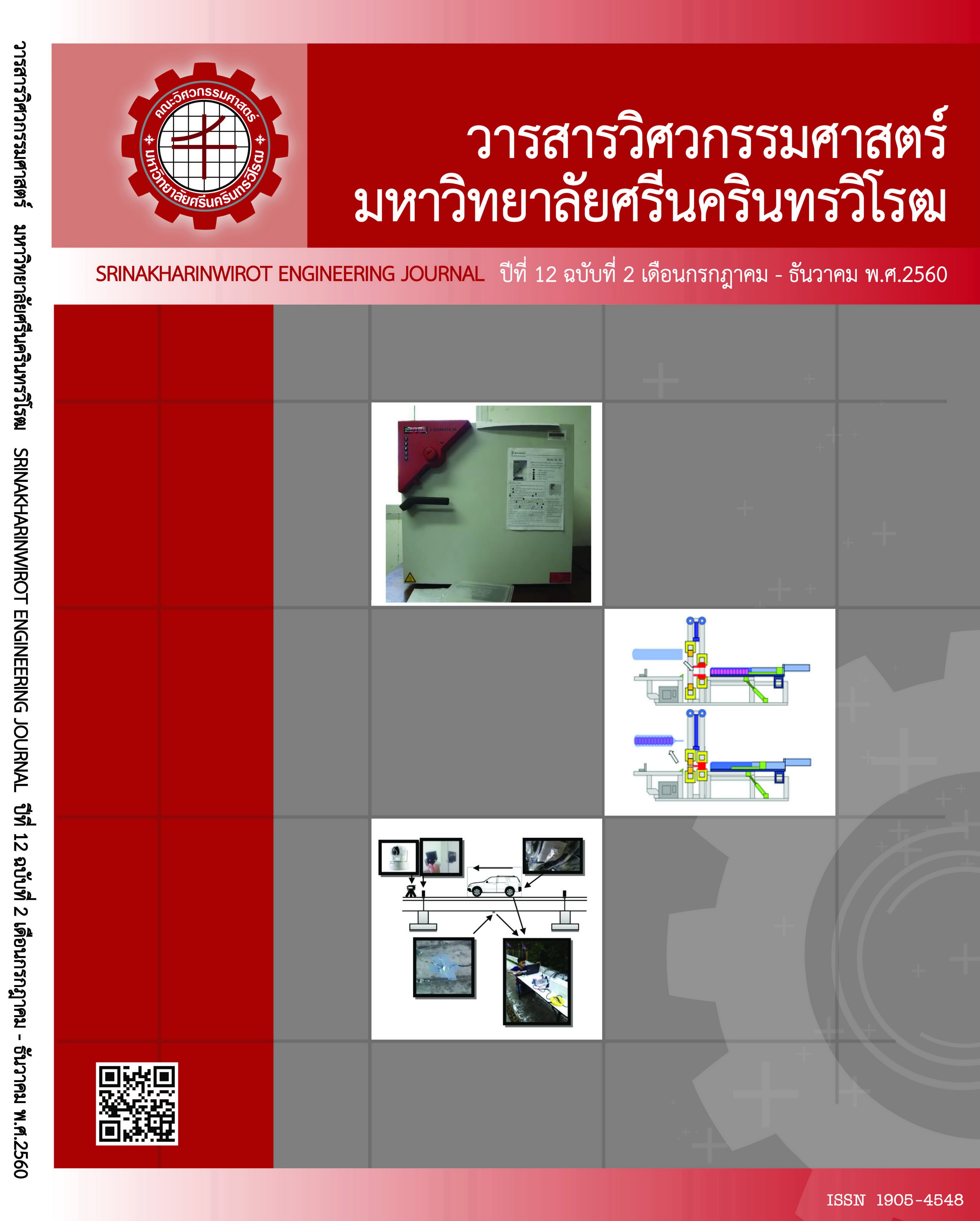Adsorption of Cutting Fluid from Turning Process by Using Modified Sugarcane Bagasse as Adsorbent
Main Article Content
Abstract
The modified sugarcane bagasse was used as an adsorbent for eliminate of cutting fluid from turning process. The effects of mass of adsorbent and initial concentration of cutting fluid were thoroughly investigated in batch adsorption systems. It was found that the point of zero charge of modified sugarcane bagasse was pH 1.6. Increasing in mass of adsorbents and initial cutting fluid concentrations increased the percent adsorption and adsorption capacity, respectively. The highest adsorption capacity, 501.7 mg/g, was obtained at 5.0 g and 49,797 mg/L for mass of modified sugarcane bagasse and initial concentration of cutting fluid, respectively. The Langmuir adsorption was rather fitted for describing the isotherm than Freundlich model. Batch designs of modified sugarcane bagasse for removal 100% of turning process wastewater amount 1 L was 0.24 g.
Article Details
Copyright belongs to Srinakharinwirot University Engineering Journal
References
[2] J.A. Anderson, B.R. Kim, S.A. Mueller and T.V. Lofton, “Composition and analysis of mineral oils and other organic compounds in metalworking and hydraulic fluids,” Crit. Rev. Env. Sci. Tec., vol. 33(1), pp. 73-109, June. 2003.
[3] C. Cheng, D. Phipps and R.M. Alkhaddar, “Treatment of spent metalworking fluids,” Water Res., vol. 39(17), pp. 4051–4063, October. 2005.
[4] P. Daengbutdee, K. Kaew-in, R. Suttanan and K. Piyamongkala, “Adsorption of methylene blue dye by rice-husk in fixed-bed column,” The Journal of KMUTNB, vol. 24 (2), pp. 399-408, May-August. 2014. (In Thai)
[5] T. Viraraghavan and G.N. Mathavan, “Treatment of oil-in-water emulsions using peat,” Oil. Chem. Pollut., vol. 4(4), pp. 261-280, December. 1988.
[6] C. Solisio, A. Lodi, A. Converti and M.D. Borghi, “Removal of exhausted oils by adsorption on mixed Ca and Mg oxides,” Water Res., vol. 36(4), pp. 899-904, February. 2002.
[7] K. Piyamongkala, S. Pongstabodee and L. Mekasut, “Effluent cutting fluid removal on to chitosan and modified chitosan,” Macromol. Res., vol. 16 (6), pp. 492-502, August. 2008.
[8] Á. Cambiella, E. Ortea, G. Ríos, J.M. Benito, C. Pazos and J. Coca, “Treatment of oil-in-water emulsion: Performance of a sawdust bed filter,” J. Hazard. Mater., vol. 131(1-3), pp. 195-199, April. 2006.
[9] V. Kittithaworn, S. Aoonpoontarik and K. Piyamongkala, “Adsorption of cutting oil by synthetic acid soil,” The Journal of KMUTNB, vol. 20 (2), pp. 266-277, May-August. 2010. (In Thai)
[10] N.K. Amin, “Removal of reactive dye from aqueous solution by adsorption onto activated carbons prepared from sugarcane bagasse pith,” Desalination, vol. 223(1-3), pp. 152-161, March. 2008.
[11] Y. Jiang, H. Pang and B. Liao, “Removal of copper (II) ions from aqueous solution by modified bagasse,” J. Hazard. Mater., vol. 164(1), pp. 1-9, May. 2009.
[12] J. Rivera-Utrill, I. Bautista-Toledo, M.A. Ferro-Garcı´ and C. Moreno-Castilla, “Activated carbon surface modifications by adsorption of bacteria and their effect on aqueous lead adsorption,” J. Chem. Technol. Biot., vol. 76(12), pp. 1209-1215, December. 2001.
[13] M.V. Lopez-Ramon, F. Stoeckli, C. Moreno-Castilla and F. Carrasco-Marin, “On the characterization of acidic and basic surface sites on carbons by various techniques,” Carbon, vol. 37(8), pp. 1215-1221, January. 1999.
[14] U.R. Lakshmi, V.C. Srivastava, I.D. Mall and D.H. Lataye, Rice husk ash as an effective adsorbent: evaluation of adsorptive characteristics for indigo carmine dye,” J. Environ. Manage., vol. 90(2), pp. 710-720, February. 2009.
[15] I. Langmuir, “Chemical reactions at low pressures,” J. Am. Chem. Soc., vol. 37(5), pp.1139-1167, May. 1915.
[16] A. Mittal, L. Kurup and J. Mittal, “Freundlich and Langmuir adsorption isotherms and kinetics for the removal of tartrazine from aqueous solutions using hen feathers,” J. Hazard. Mater., vol. 146(1-2), pp. 243-248, July. 2007.
[17] L.D. Benefield, J.F. Judkins and B.L. Weand, Process Chemistry for Water and Wastewater Treatment. New Jersey, Prentice-Hall, pp. 202-209, 1982.
[18] M.C. Ncibi, “Applicability of some statistical tools to predict optimum adsorption isotherm after linear and non-linear regression analysis,” J. Hazard. Mater., vol. 153(1-2), pp. 207-212, May. 2008.
[19] B. Crittenden and W.J. Thomas, Adsorption Technology & Design. Oxford, Butterwouth-Heinemann, pp. 38-39, 1998.
[20] V. Vadivelan and K. Vasanth Kumar, “Equilibrium, kinetics, mechanism, and process design for the sorption of methylene blue onto rice husk,” J. Colloid. Interf. Sci., vol. 286(1), pp. 90-100, June. 2005.


